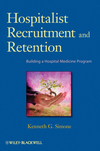New Book Shows How to Build and Sustain a Successful Hospital Medicine Program
 Hospitalist Recruitment and Retention: Building a Hospital Medicine ProgramISBN: 978-0-470-46078-8
Paperback
224 pages
December 2009, Wiley-Blackwell
|
|||||||
New Book Shows How to Build and Sustain a Successful Hospital Medicine Program
Recruitment and retention of physicians in all specialties is a national challenge, and it is expected to become even more difficult due to an impending physician shortage. As relative newcomers to the long line of medical specialists, hospitalists pose special challenges. What will convince a hospitalist to join one organization over another? What might prevent a hospitalist from considering a certain assignment?
Now, recruiters can benefit from the experience of Kenneth G. Simone, the pioneer who founded the first successful hospitalist program in Maine. In his new book, Hospitalist Recruitment and Retention: Building a Hospital Medicine Program, he reveals what works, what doesn’t, and which issues seem to be emerging as the “deal-makers” and “deal-breakers” with these important specialists.
“A well-run hospitalist program will support the delivery of quality care, support patient safety, and support the delivery of cost effective and efficient care,” Dr. Simone explains. “This should provide the hospital with cost savings. It may also allow the hospital to capture more monies related to pay-for-performance initiatives. These are just some of the reasons why recruiting, and keeping, good hospitalists is essential.”
The movement toward evidence-based practice guidelines requires hospitalists to be aware of current trends in the healthcare industry, including Joint Commission Core measures, CMS initiatives (e.g. Pay for Performance, Do Not Pay, Value-Based Purchasing), and quality and patient safety initiatives by groups such as NQF (National Quality Forum), Leapfrog, IHI (Institute for Healthcare Improvement), and AHRQ (Agency for Healthcare Research and Quality). Because hospitalists serve on many of the key hospital committees that create quality care and patient safety initiatives, they can drive efficiencies and improved knowledge throughout the hospital.
Simone’s book is the first complete guide to recruiting and retaining these uniquely-positioned specialists. In addition to providing all the tools and guidance needed to build a new hospital medicine program, he shows how to reinvigorate and maintain an established hospitalist program.
The book explains how to:
- Develop a recruitment plan that attracts the right people and clearly sets forth expectations
- Hire the best people to meet organizational objectives
- Implement an effective retention plan that keeps high-quality staff motivated and committed to excellence
It also discusses:
- The significance of current trends in hospital medicine, such as how location, lifestyle, and practice model may be more important than salary for some hospitalists, and the impact of the increasing use of NPCs (Physician Assistants and Nurse Practitioners)
- Key factors and tips in successful hospitalist recruitment and retention, such as clearly discussing the vision, values, and objectives of both the practice and candidate as well as being transparent about the problems and potential solutions within the program
- The role of the hospitalist in recruitment, retention, and stabilization of physicians in their communities
With the hospital industry under enormous pressure to control costs without sacrificing quality of care, this practical guide should be mandatory reading for professionals involved in setting health care policy.





